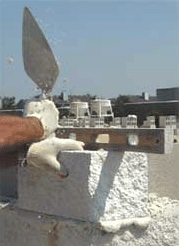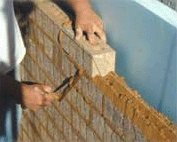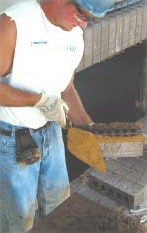Mixing Mortar for Properties - The Prescription Mortar Method
By Tom Inglesby
 Does any one unit fit all situations? Not likely. Since the units are highly variable, why couldn't the mortar be too? Matching unit and mortar is the answer and that's 'prescription mortar.'
Does any one unit fit all situations? Not likely. Since the units are highly variable, why couldn't the mortar be too? Matching unit and mortar is the answer and that's 'prescription mortar.'
It's a sticky topic, we know, but mortar is one of the most basic elements of masonry construction. Yes, you can build without it these days as dry-stack blocks are becoming more popular but when nature becomes pushy, you want that tall wall to withstand gale force winds and even earthquakes. That usually means mortar joints.
What is mortar? "Any of various bonding materials used in masonry, especially a plastic mixture of cement or lime, sand, and water that hardens in place and is used to bind together bricks or stones." At least, that's what the American Heritage Dictionary says.
The people who make the bricks, as represented by the Brick Institute of America (BIA), go into more depth, as you would expect. "Mortar is the bonding agent that integrates brick into a masonry wall. Mortar must be strong, durable, and capable of keeping the wall intact; it must help to create a water resistant barrier; and it must accommodate dimensional variations and physical properties of the brick when laid. These requirements are influenced by the composition, proportions and properties of the mortar."
What we find is that two of those factors ? proportions and properties ? actually govern the third, composition. According to Brian Carney, vice president and general manager of Spec Mix, Mendota Heights, Minn., "You need to be concerned about what the requirements are because there are two different specifications in ASTM C 270, the property specification and the proportion specification. Some architects specify property and other proportions. It does make a difference in what you end up with."
Let's say the specification calls for Type S mortar. However, if it calls for proportion Type S, that's telling you to follow the specific formula, "This is the recipe that I want you to use to make my Type S mortar." So, for Type S you take one part of cement ? one "part" equals one bag equals one cubic foot ? and add in a half part of lime. Then you add up the volume of those two components (1.5), multiple by three and that tells you how many parts of sand to put in the mixer ? in this case, 4.5 parts sand.
"We tell the architect that we'll put in our 3000 pound bulk bag of Spec Mix the equivalent of one bag of cement, half bag of lime, and 4.5 cubic feet of sand by volume," says Carney. "That means that you're probably going to have a mortar with a laboratory determined compressive strength at anywhere from 3,500 psi to 4,000 psi, maybe higher. While the designer intended for 1800 psi type S mortar, we have produced a mortar with approximately twice the compressive strength of what was intended, creating a possible compatibility mismatch between the mortar and the masonry unit."
Now, if the architect specifies Type S property mortar, the methodology changes, often for the better. Carney says, "It still has to be made from Portland cement but we can design the mix and formulate the recipe to what we need to achieve the properties of Type S ? for example, the requirements of 1800 psi. Often masons and architects are thinking that one bag of cement and half a bag lime is the best mix for a Type S mortar, but what they end up making is in excess of a 'property Type M' mortar."
Chris Darner, Construction Products sales representative at Quikrete, Atlanta, Ga., explains, "Type M mortar is generally intended for below grade construction ? foundation walls and heavy load bearing walls. Type S mortar is generally used for above grade block construction and some brick, depending on the architect. Type N is used in brick construction. They have different consistencies because they are made with different strength cement. The proportion that is added to the mix stays the same but the bond strength of the cement is greater in the M as opposed to the N and S."
As Darner says, Type M is a very strong mortar that might not be right for the integrity of the masonry assembly. When the mortar is too hard, masonry walls won't move in a thermal dynamic plane properly, as they were designed to do.
 "In fact, that is why they have control and expansion joints in brick and block walls ? the wall is going to expand and contract and that movement needs to be accommodated for in the design," notes Carney. "And, if the selected mortar has a high cement content, excessive shrinkage of mortar from the face shell of the masonry unit is more likely to occur."
"In fact, that is why they have control and expansion joints in brick and block walls ? the wall is going to expand and contract and that movement needs to be accommodated for in the design," notes Carney. "And, if the selected mortar has a high cement content, excessive shrinkage of mortar from the face shell of the masonry unit is more likely to occur."
While mortar may seem like a simple product ? most cakes use more ingredients ? there are a surprising number of combinations that are found in both onsite and "factory" mortar. A little of this, a little of that, and the overall value of the mortar can change significantly. There are, obviously, specifications spelled out to assure that the mixture meets design requirements. ASTM specifies this for the U.S. and that information is readily available.
And there are regional preferences to be considered, determined both by the experiences of the mason and by local requirements. For example, some mortar mixes are not approved for use in certain states due to seismic conditions. "Most of our mortars are straight Portland lime mortars," says Stan Harwell, eastern regional manager for Spec Mix, based in Virginia Beach, Va. "However, in the southeast we formulate a lot of mortars with masonry cements. Those can only be used in non-seismic zones, not in seismic zone II or greater, such as California, Colorado, or Utah. Masonry cement is Portland cement with many different additives in it such as bonding agents, set controllers, water repellants, air-entraining agents, and inert fillers. Because masonry cement already has these additives put into it at the mill, we don't have to add anything."
Convenience and good workability are the reasons masonry cements are widely used. ASTM C 91 "Specification for Masonry Cement" defines masonry cement as "a hydraulic cement, primarily used in masonry and plastering construction, consisting of a mixture of Portland or blended hydraulic cement and plasticizing materials such as limestone, hydrated or hydraulic lime, together with other materials introduced to enhance one or more properties such as setting time, workability, water retention, and durability."
Masonry cement typically has a higher air holding capability than Portland lime cement. "Portland limes can, by ASTM standards, go up to 12 percent," comments Harwell. "By ASTM C 270, that same mortar, if we use a masonry cement, can go up to 18 percent of air by volume."
Because high air entrainment can significantly reduce the bond between the mortar and masonry units or reinforcement, BIA says the use of air-entrained Portland or blended hydraulic cements is not recommended. Most building codes have lower allowable flexural tensile stress values for mortars made with air-entrained Portland cement.
While ASTM C 91 provides specific criteria for physical requirements and performance properties of masonry cements, the constituents may vary depending on the manufacturer, local construction practices and climatic conditions. Model building codes generally allow flexural tensile stress values for masonry built with masonry cement mortars that are lower than those for masonry built with non air-entrained Portland cement and lime mortars. Therefore, the use of masonry cement should be based on the requirements of the specific application.
At companies like Spec Mix, the future will be one where mortars are premixed to property specifications and flexibly use additives as needed to accomplish specific tasks. It's what Harwell calls "prescription mortars, which have the ability to match mortars with the physical properties of the masonry unit, the structural requirements for the project, the weather conditions, and the desired workability for the mason."
 He explains, "Why do we want to use a mortar in August, when it's very hot and dry, with a very absorptive unit like a brick ? one that's very soft and will suck all the water out of the mortar fast? That increases the chance of having a dry out on the wall ? all the water evaporating before the cement can completely hydrate.
He explains, "Why do we want to use a mortar in August, when it's very hot and dry, with a very absorptive unit like a brick ? one that's very soft and will suck all the water out of the mortar fast? That increases the chance of having a dry out on the wall ? all the water evaporating before the cement can completely hydrate.
"Then," he continues, "why would we want to use that same mortar in January, when it's cold and rainy, with a brick that has no absorption? As an industry we need to get to the point where we can manufacture prescription mortars by blending Portland cement, hydrated lime, and certain prescribed additives along with a good mason sand that will create a mortar that works well with specified units, whether brick or block, under job site conditions."
Carney adds, "If we can, we first have to influence architects or contractors to use property mortars. What we try to do is design mortars that achieve the right compressive strength value, water retention, and air content requirements by ASTM specifications. Of course, we'll do whatever the architects specify. If they prescribe a Type S proportion mix, yes we can make that. But I don't think they fully understand what the outcome is going to be. We do, but the designer doesn't."
That result would be a mortar version of overkill. "It's going to be an excessively strong mortar 99 out of 100 times," Harwell says. "And if it's an excessively strong mortar, that means that it's going to have quicker set times in the summer, making it unworkable for the mason. These quicker set times cause masons to add additional water to their mortar on the mud board, changing the water to cement ratio. In turn, that's going to affect such things as the color of the mortar in the wall and the consistency when tooling the joints as well as the ultimate compressive and bond strength of the in-place mortar."
Carney reminds us, "There are two ways to make mortar ? to a proportion specification or a property specification. Basically, one is a recipe and one simply meets performance criteria. Then you go on to the next step, which is to select the masonry unit for the project and determine it's physical properties. Then simply match a mortar that will enhance and meet the physical requirements of the masonry unit. That's prescription mortars, manufacturing the best possible mortar for that masonry unit."
Carney pulls out the ASTM C 270 specifications and says, "If you read the summary, it says, 'Bond is probably the most important single property of a conventional mortar. To obtain optimal bond, use a mortar with properties that are compatible with the masonry units to be used.' After the initial rate of absorption (IRA) on a particular unit is determined, the mason can decide which mortar best suits the needs of the project.
"If it's a high IRA," Carney explains, "the mortar must have a high level of water retentively. If that unit absorbs the water too quickly, you won't have very good bond. If you have a brick that's very hard, you have to design a mortar for it. A higher cement to lime ratio is required because the unit will not absorb much water. You have to design a mortar that will allow you to build your wall with good set times."
You have to follow your building codes, that's a given. "However," Carney quickly says, "there are ways to talk to architects and officials, to educate them to use the best mortar on the job. That's what we do. If you design by property specifications you'll likely get the right mortar for the right unit for the right application."
About the Author
Tom Inglesby is a San Diego-based freelance writer whose work has appeared in numerous online and print publications. He is the winner of the Construction Writers Association's 2002 Boger Award for Special Reports.


















